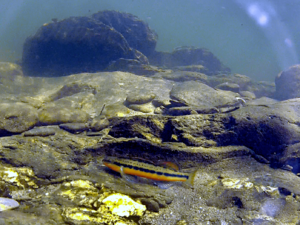Tangerine darter facts for kids
Quick facts for kids Tangerine darter |
|
|---|---|
 |
|
| Adult male tangerine darter | |
| Conservation status | |
| Scientific classification | |
| Synonyms | |
|
Cottogaster aurantiacus Cope, 1868 |
The tangerine darter (Percina aurantiaca) is a small, colorful freshwater fish. It is also sometimes called the "river slick." This fish is a type of ray-finned fish, which means it has fins supported by bony rays. It belongs to a group of fish called darters. Darters are part of the larger family called Percidae, which includes other well-known fish like perches.
Tangerine darters live in the eastern United States. They can grow to be about 11 to 18 centimeters (4.3 to 7.1 inches) long. Male tangerine darters are a bright orange-red color, while females are yellow. These fish are insectivores, meaning they eat insects. They find their food by picking insect larvae off water plants and the river bottom. Sometimes, they even roll small stones over to find hidden prey.
They lay their eggs in late spring and early summer. This usually happens in shallow, fast-moving parts of rivers with sand or gravel. Even though pollution can be a problem in some areas, the tangerine darter is quite common. Because of this, the International Union for Conservation of Nature says it is a species of "least concern".
Contents
What Does a Tangerine Darter Look Like?
Tangerine darters are usually about 11 to 18 centimeters (4.3 to 7.1 inches) long. This is quite large for a darter fish!
Male tangerine darters are very brightly colored. They are typically a vibrant orangish-red. Females are not as colorful; they are usually yellow.
Where Do Tangerine Darters Live?
Tangerine darters are a common fish species. However, they only live in specific places. They need clear, cool streams in the southern Appalachian Mountains.
You can find the tangerine darter in the mountainous areas of the upper Tennessee River system. They prefer smaller rivers. They are most often seen in the Emory, Hiwassee, Little, Little Pigeon, and Tellico rivers. Their home range includes eastern Tennessee, northern Georgia, and western North Carolina, and Virginia.
Habitat and Life Cycle
The tangerine darter lives in clear, cool creeks or small rivers. In these rivers, they like areas with large boulders, bedrock, and a gravel bottom. They also enjoy swimming in the deeper, fast-moving parts of these rivers called riffles. When winter comes, the tangerine darter moves to deeper, calmer pools.
Reproduction and Spawning
Tangerine darters lay their eggs, a process called spawning, from late spring to summer. They choose shallow, sandy, or gravelly riffles with steady flowing water. The breeding season starts in May and lasts through July. This timing is triggered by the water temperature.
Tangerine darters usually start spawning when they are about three to four years old. However, they become ready to reproduce much earlier. Males can reproduce at one year old, and females at two years old. These fish typically live for about four years.
When spawning, the male first climbs onto the female's back. The female then scatters her eggs over the gravel. At the same time, the male releases his milt (sperm) to fertilize the eggs. Both fish make a quivering motion during this process. Females choose the males with the brightest orange color, a black line, and some blue where the orange meets the black.
Males become very territorial during the mating season. They will protect their chosen spawning riffles from other males. A female can lay anywhere from 120 to 1,100 eggs. The tangerine darter does not stay to care for its eggs after they are laid. Young fish, called juveniles, are found in calmer water. They grow to be about 5 to 8 centimeters (2 to 3 inches) long in their first year.
What Do Tangerine Darters Eat?
The tangerine darter is an insectivorous fish, meaning it eats insects. Young tangerine darters mainly eat mayflies and midges. Adult darters also eat mayflies, along with caddisflies.
Tangerine darters find their food by searching through water plants. They eat the aquatic insects they find on the plants. Adult darters are big enough to roll over small pieces of gravel to look for hidden prey. Even though the tangerine darter is not a fish caught for sport, sometimes fly fishermen catch them by accident using artificial flies that look like mayflies and caddisflies.
Threats to Tangerine Darters
The biggest danger to the tangerine darter is when their habitat gets damaged. This can happen because of pollution coming from specific places (like a factory pipe) or from many different places (like runoff from farms). It also happens due to erosion and sedimentation, which means dirt and sand wash into the rivers.
On the Pigeon River in East Tennessee, tangerine darter numbers went down a lot but then recovered. In 1908, a paper mill was built on the river. This mill released waste that harmed many native fish. In the 1980s, the mill cleaned up its waste, and the river has been getting better. Tangerine darters have even been successfully brought back to the Pigeon River downstream from the paper mill.
Overall, the tangerine darter lives in a wide area and has many groups of fish. Its total population is large, and there are no major threats right now. Because of this, the International Union for Conservation of Nature has said its conservation status is of "least concern".


